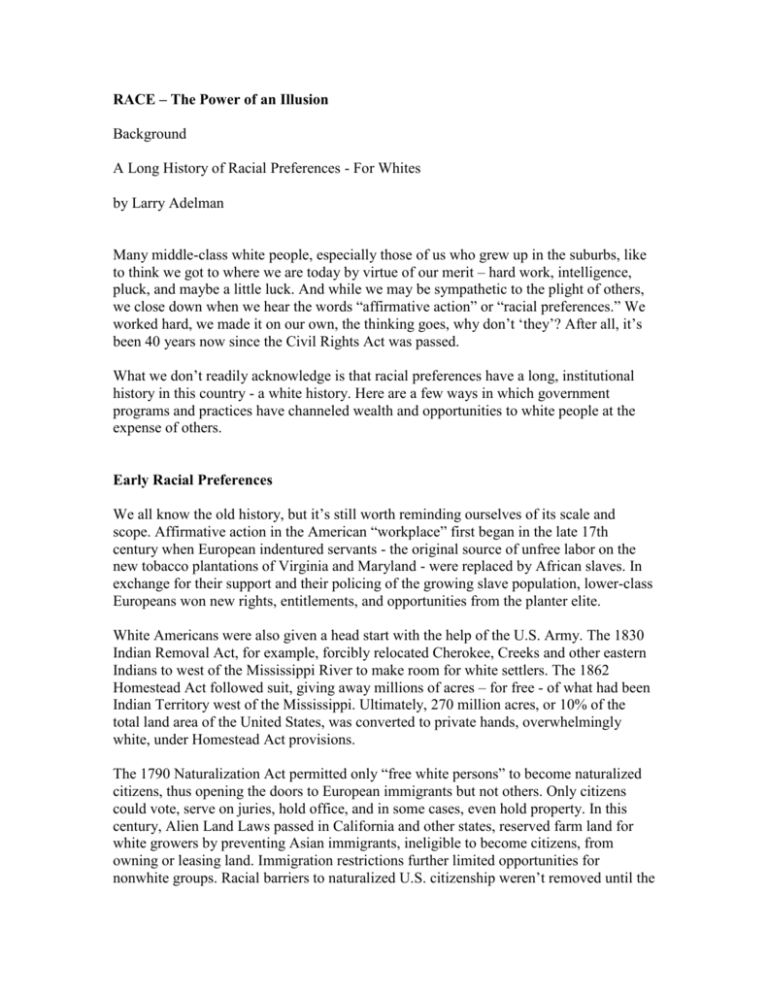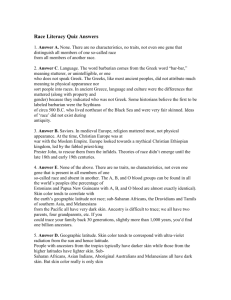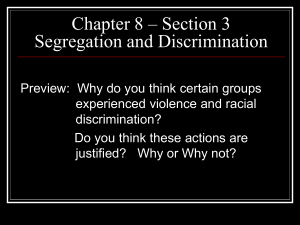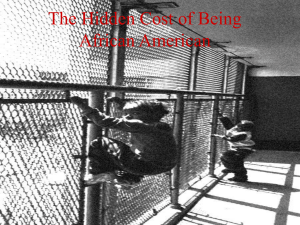RACE – The Power of an Illusion
advertisement

RACE – The Power of an Illusion Background A Long History of Racial Preferences - For Whites by Larry Adelman Many middle-class white people, especially those of us who grew up in the suburbs, like to think we got to where we are today by virtue of our merit – hard work, intelligence, pluck, and maybe a little luck. And while we may be sympathetic to the plight of others, we close down when we hear the words “affirmative action” or “racial preferences.” We worked hard, we made it on our own, the thinking goes, why don’t ‘they’? After all, it’s been 40 years now since the Civil Rights Act was passed. What we don’t readily acknowledge is that racial preferences have a long, institutional history in this country - a white history. Here are a few ways in which government programs and practices have channeled wealth and opportunities to white people at the expense of others. Early Racial Preferences We all know the old history, but it’s still worth reminding ourselves of its scale and scope. Affirmative action in the American “workplace” first began in the late 17th century when European indentured servants - the original source of unfree labor on the new tobacco plantations of Virginia and Maryland - were replaced by African slaves. In exchange for their support and their policing of the growing slave population, lower-class Europeans won new rights, entitlements, and opportunities from the planter elite. White Americans were also given a head start with the help of the U.S. Army. The 1830 Indian Removal Act, for example, forcibly relocated Cherokee, Creeks and other eastern Indians to west of the Mississippi River to make room for white settlers. The 1862 Homestead Act followed suit, giving away millions of acres – for free - of what had been Indian Territory west of the Mississippi. Ultimately, 270 million acres, or 10% of the total land area of the United States, was converted to private hands, overwhelmingly white, under Homestead Act provisions. The 1790 Naturalization Act permitted only “free white persons” to become naturalized citizens, thus opening the doors to European immigrants but not others. Only citizens could vote, serve on juries, hold office, and in some cases, even hold property. In this century, Alien Land Laws passed in California and other states, reserved farm land for white growers by preventing Asian immigrants, ineligible to become citizens, from owning or leasing land. Immigration restrictions further limited opportunities for nonwhite groups. Racial barriers to naturalized U.S. citizenship weren’t removed until the McCarran-Walter Act in 1952, and white racial preferences in immigration remained in place until 1965. In the South, the federal government never followed through on General Sherman’s Civil War plan to divide up plantations and give each freed slave "40 acres and a mule" as reparations. Only once was monetary compensation made for slavery, in Washington, D.C. There, government officials paid up to $300 per slave upon emancipation - not to the slaves, but to local slaveholders as compensation for the loss of their property. When slavery ended, its legacy lived on not only in the impoverished condition of Black people but in the wealth and prosperity that accrued to white slaveowners and their descendants. Economists who try to place a dollar value on how much white Americans have profited from 200 years of unpaid slave labor, including interest, begin their estimates at $1 trillion. Jim Crow laws, instituted in the late 19th and early 20th century and not overturned in many states until the 1960s, reserved the best jobs, neighborhoods, schools and hospitals for white people for several more generations. The Advantages Grow, Generation to Generation Less known are more recent government racial preferences, first enacted during the New Deal, that directed wealth to white families and continue to shape life opportunities and chances today. The landmark Social Security Act of 1935 provided a safety net for millions of workers, guaranteeing them an income after retirement. But the act specifically excluded two occupations: agricultural workers and domestic servants, who were predominately African American, Mexican, and Asian. As low-income workers, they also had the least opportunity to save for their retirement. They couldn’t pass wealth on to their children. Just the opposite. During old age, their children had to support them. Like Social Security, the 1935 Wagner Act helped establish an important new right for white people. By granting unions the power of collective bargaining, it helped millions of white workers gain entry into the middle class over the next 30 years. But the Wagner Act permitted unions to exclude non-whites and deny them access to better paid jobs and union protections and benefits such as health care, job security, and pensions. Many craft unions remained nearly all-white well into the 1970s. In 1972, for example, every single one of the 3,000 members of Los Angeles Steam Fitters Local #250 was still white. But it was another racialized New Deal program, the Federal Housing Administration, that helped generate much of the wealth that so many white families enjoy today. These revolutionary programs made it possible for millions of average white Americans - but not others - to own a home for the first time. The government set up a national neighborhood appraisal system, explicitly tying mortgage eligibility to race. Integrated communities were ipso facto deemed a financial risk, a policy known today as “redlining.” Between 1934 and 1962, the federal government backed $120 billion of home loans. More than 98% went to whites. Of the 350,000 new homes built with federal support in northern California between 1946 and 1960, fewer than 100 went to African Americans. These government programs made possible the new segregated white suburbs that sprang up around the country after World War II. Government subsidies for municipal services helped develop and enhance these suburbs further, in turn fueling commercial investments. New freeways tied the suburbs to central business districts, but they often cut through and destroyed the vitality of non-white neighborhoods in the central city. Today, Black and Latino mortgage applicants are still 60% more likely than whites to be turned down for a loan, even after controlling for employment, financial, and neighborhood factors. According to the Census, whites are more likely to be segregated than any other group. As recently as 1993, 86% of suburban whites still lived in neighborhoods with a black population of less than 1%. Reaping the Rewards of Racial Preference One result of the generations of preferential treatment for whites is that a typical white family in 2005 has on average ten times the net worth, of a typical African American family, according to the U.S. Census. Even when families of the same income are compared, white families have more than twice the wealth of Black families. Much of that wealth difference can be attributed to the value of one’s home, and how much one inherited from parents. But a family’s net worth is not simply the finish line, it’s also the starting point for the next generation. Those with wealth pass their assets on to their children - by financing a college education, lending a hand during hard times, or assisting with the down payment for a home. Some economists estimate that up to 80 percent of lifetime wealth accumulation depends on these intergenerational transfers. White advantage is passed down, from parent to child to grand-child. As a result, the racial wealth gap and the head start enjoyed by whites - appears to have grown since the civil rights days. In 1865, just after Emancipation, it is not surprising that African Americans owned only 0.5 percent of the total worth of the United States. But by 1990, a full 135 years after the abolition of slavery, Black Americans still possessed only a meager 1 percent of national wealth. As legal scholar john a. powell says in the documentary series Race – The Power of an Illusion, “The slick thing about whiteness is that whites are getting the spoils of a racist system even if they are not personally racist.” But rather than recognize how “racial preferences” have tilted the playing field and given us a head start in life, many whites continue to believe that race does not affect our lives. Instead, we chastise others for not achieving what we have; we even invert the situation and accuse non-whites of using “the race card” to advance themselves. Or we suggest that differential outcomes may simply result from differences in "natural" ability or motivation. However, sociologist Dalton Conley’s research shows that when we compare the performance of families across racial lines who make not just the same income, but also hold similar net worth, a very interesting thing happens: many of the racial disparities in education, graduation rates, welfare usage and other outcomes disappear. The "performance gap" between whites and nonwhites is a product not of nature, but unequal circumstances. “Colorblind” policies that treat everyone the same, no exceptions for minorities, are often counter-posed against affirmative action. But colorblindness today merely bolsters the unfair advantages that colorcoded practices have enabled white Americans to long accumulate. Isn’t it a little late in the game to suddenly decide that race shouldn't matter? Larry Adelman is executive producer of RACE – The Power of an Illusion, a three part documentary series scrutinizing the very idea of race and available on video and DVD from California Newsreel at www.newsreel.org. Visit the companion Web site at www.pbs.org/Race. San Francisco Chronicle, Sunday, June 29, 2003








